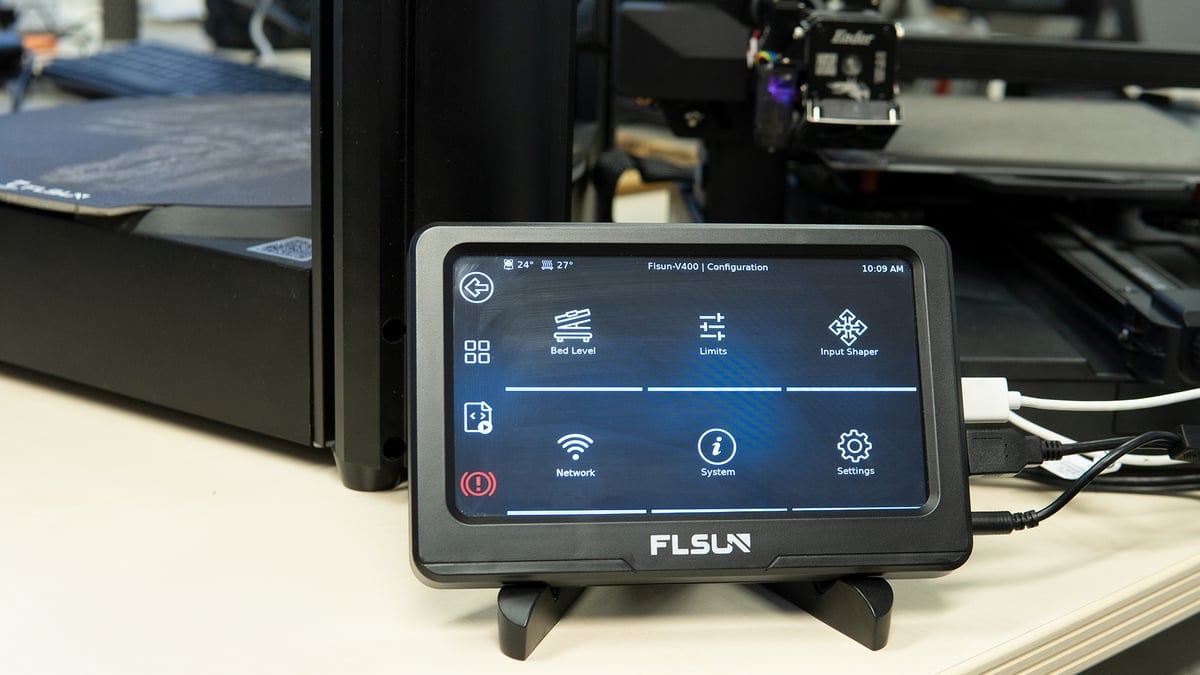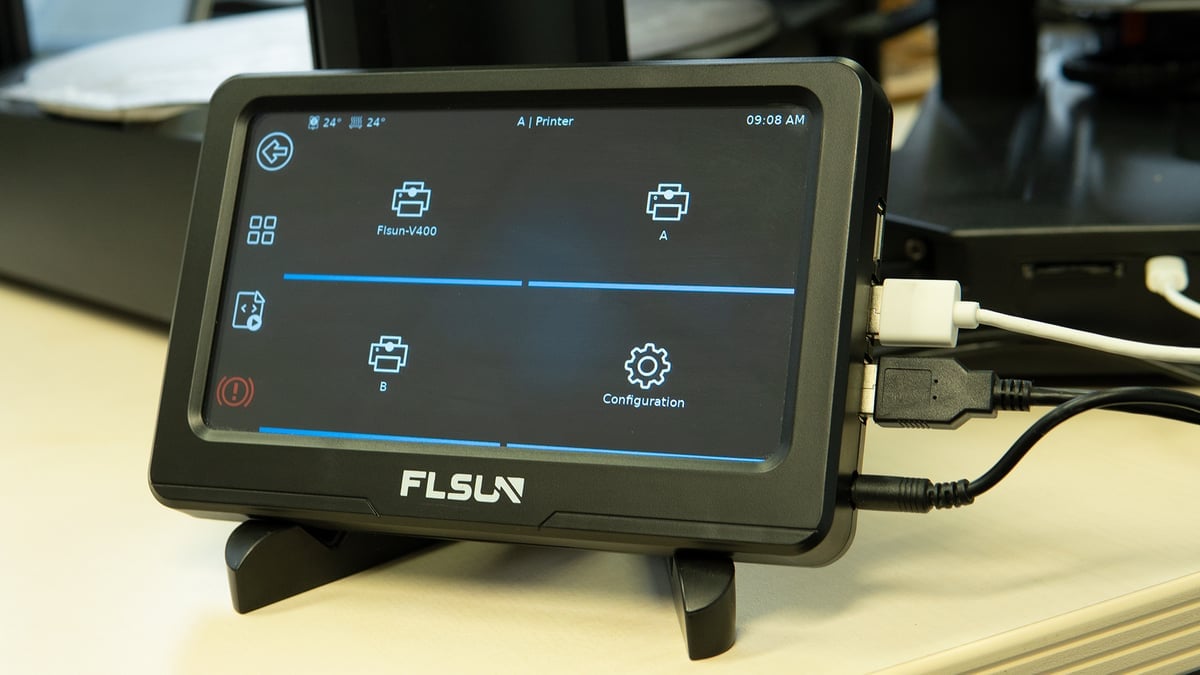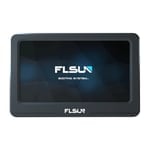Klipper experienced a surge in popularity over the course of 2022, and with that came the exciting release of Klipper hardware from notable manufacturers both in the form of 3D printers with Klipper pre-installed and as Klipper interfaces. Klipper interfaces, single-board computers (SBCs) with Klipper pre-installed, have garnered plenty of interest as a way for users less familiar with compiling firmware and usings SBCs to get on the platform – or at least as an interface that’s a little more aesthetically pleasing than the Raspberry Pis most of us have hanging off our machines.
The one manufacturer who released both is Flsun, a company known for its speedy delta 3D printers. It released both the V400 3D printer – named after the 400 mm/s the company says it can reliably print at – and the Speeder Pad Klipper interface last year.
The V400 actually includes a “Speeder Pad” as its interface. It’s the same hardware, but ships with different software than the Speeder Pad that’s sold independently. Fortunately, users can flash the included screen with a Speeder Pad image to get the full experience should they wish to – but should they? We’ve found a few reasons users may prefer to stick to the default V400 Speeder software over the course of our review. And a few reasons to steer clear of the Speeder Pad in the first place if you’re looking for an easier Klipper experience.
What is Klipper?
If you’re not already familiar with Klipper, it’s a firmware that came about as an alternative to Marlin when the limited processing capabilities of 8-bit mainboards started bottlenecking print speeds. Instead of using the 3D printer’s primary mainboard as the main processing powerhouse, Klipper is installed on a secondary Linux-based computer – usually a single-board computer (SBC) like a Raspberry Pi – which takes over the heavy G-code processing. The printer’s mainboard is relegated to simple execution with the lightweight MCU firmware.
32-bit mainboards and Marlin 2 helped to catch up a bit, but when you see people talking about printing faster by installing Klipper, that added processing power is still a big part of why. The other reasons can be primarily attributed to two features: input shaping and pressure advance. The latter is Klipper’s version of Marlin’s linear advance that improves quality by ensuring consistent pressure in the nozzle, the former a method to eliminate ringing by accounting for vibrations during prints (a feature Marlin has recently added).
Installing Klipper is fairly straightforward if you’re familiar with SBCs or software in general, but it can be a little intimidating if you’re not. That’s one reason recent releases like Flsun’s Speeder Pad are so exciting – they dramatically simplify the tricky installation process.
Another reason plug-and-play solutions like the Speeder Pad are noteworthy is that they save you the hassle of sourcing an SBC, touchscreen interface, and casing. Getting your hands on a suitable Raspberry Pi is still difficult right now, and these products sidestep the problem.
What is the Speeder Pad?
Flsun’s Speeder Pad is a system on module (SoM) behind a 7-inch 1024 x 600 touchscreen running a pre-installed version of Klipper with Mainsail as the web interface and Flsun’s version of the Klipper Screen touchscreen OS. The board hosts an Allwinner R818 SoC with 1 GB of RAM and 16 GB of EMMC storage.

The Speeder Pad comes with pre-configured Klipper profiles for Flsun’s V400, Super Racer (SR), QQ S-Pro, and Q5 3D printers, as well as for five combinations of third-party chipsets and print bed sizes. In reality, it’s three chipsets in a variety of print bed sizes –which are easily changed in the config file — made to match some popular 3D printers.
The pre-existing profiles are:
To use the Speeder Pad with any of these pre-configured profiles, users must simply download the corresponding .BIN file from Flsun’s website and flash their printer with it.
The Speeder Pad’s initial release strictly limited users to these pre-configured profiles by barring SSH access: preventing users from connecting to the screen and compiling MCU firmware for 3D printers not suitable to these presets. But Flsun quickly released an update in the form of a system image that allowed users to update and gain SSH access. Fortunately, this system image allows V400 owners to flash their Speeder Pads with the different software, too, adding some utility to the device that wasn’t there before.
A Note on Fire Hazards
Be aware, using the wrong printer profile – one without a pinout matching the 3D printer’s mainboard – could result in the hot end heating indefinitely without thermal runaway protection. In fact, selecting the wrong pre-installed profile for the printer in the Speeder Pad’s matching port can cause this issue. And with Flsun’s own products, no less. If you run the A, B, or D profiles (all configured for an stm103 mainboard) on a port where an MKS Robin board is plugged in (like in the Flsun V400 and SR), the hot end will heat indefinitely without command. Talk about an oversight.
To be fair, this is a problem that exists with Klipper in general, presumably caused by varying pinouts in mainboard designs. We’ve run into it before with multi-instance Klipper installations on other hosts, but it’s strange to us that Flsun would ship a product with pre-configured profiles that play so dangerously with its own products — especially for a product seemingly made just for people less familiar with Klipper. It doesn’t seem like it would be very difficult for some minor thoughtlessness to cause a major accident here.
The lesson: be sure the profile you flash is for the correct 3D printer or chipset that Flsun specifies in the Speeder Pad’s manual (the information should really be more detailed and available elsewhere), but also be sure the printer profiles you have loaded play nice with your machines. If not, you’ll need to be very cautious of which port is for which profile — mixing them up could be disastrous.
First Impressions
Our initial impressions of the Speeder Pad were mixed. Flsun has packaged the device well, so opening it feels more like unboxing a new tablet, and it comes with some extras the V400’s included Speeder Pad doesn’t — namely an ADXL345 accelerometer and matching cable. But, despite being a rather costly product at ~$190, Flsun didn’t include a stand for the screen. We can, of course, just print one, but that’s not exactly the experience we expected. It’s especially baffling since the V400 already includes a stand for the same screen. An annoying omission, but mostly inconsequential.
The Speeder Pad itself is a simple product, really. It’s a touchscreen SoM with Klipper and a few printer profiles pre-installed. Unfortunately, that simplicity means the product is quite limited out of the box, and we ran into problems immediately.
The first 3D printer we wanted to try with the Speeder Pad was Flsun’s Super Racer (SR): a delta printer released before the V400 that runs Marlin by default but is a popular machine to use with Klipper. However, we were unable to conduct this testing out of the box due to our SR’s mainboard.

Being one of the earlier units, our SR contains an SKR 1.3 mainboard instead of the MKS Robin Nano that was included later. Though the readme file included in the SR’s .BIN download package says the included files “will automatically identify lpc1768 and stm32 F407 chips” and install the appropriate firmware, the included SR profile simply didn’t work. Flsun confirmed the Speeder Pad won’t work with SKR boards, which is baffling considering the readme. In order to use this printer, we’d have to flash the Speeder Pad with a more recent system image and SSH in to compile our own firmware. So, if you’re looking for a simplified Klipper experience with your Flsun SR, be sure that yours has a Robin mainboard before you spring for the interface. Then heed the safety warning above.
Upon moving on and testing the Speeder Pad with the Ender 3 S1 Pro, our experience was smoother. Flsun’s provided firmware installed easily and the screen worked as intended, allowing us to switch between the V400 and Klipperized S1 Pro seamlessly. But, there were still some oversights. When we tried to control the printers from the Mainsail web interface, we found the ports for Klipper’s instances weren’t set up correctly and required us to enter them (7125, 7126, and 7127) manually. It’s a simple fix, but were we not familiar with Klipper already, we’d have had no idea how to control any printer wirelessly other than the one assigned to port 1.
Advanced Features
One of the biggest draws to Klipper is its advanced calibration functions of input shaping and pressure advance that help 3D printers work their magic faster and in better quality. But, the implementation of these features on the Speeder Pad – or lack thereof – is possibly the worst part of the product’s custom Klipper OS.
With the Speeder Pad’s default third-party profiles, these features simply don’t exist as an easily navigable option on the Speeder Pad’s interface. If you want to calibrate your third-party printers with these features, you’re going to need to do it through the console – just like you would need to with a DIY Klipper host.

For Flsun’s V400, calibrating input shaping is possible through the Speeder Pad itself, at least, but there could have been more thought here. Though the Speeder Pad does include an ADXL345 accelerometer and microUSB cable to conduct input shaping with, there are no instructions on how to go about doing it and no obvious mounting place for the accelerometer. Pressure advance, meanwhile, is nowhere to be found in the interface, forcing users to again lean on the console for this integral Klipper feature – just like a DIY Klipper host.
We won’t go into detail about how to calibrate input shaping or pressure advance here, but be sure to read our guide on each if you’ve found yourself needing to use the console:
Is It Worth It?
On its own island, the Speeder Pad is an okay piece of kit that can help unfamiliar users skirt the sometimes daunting process of figuring out how to install Klipper and, to a limited extent, compile the 3D printer’s MCU firmware. Especially for users inexperienced with SBCs and looking to use multiple 3D printers with Klipper (and so would need to figure out how to use Kiauh to install multiple Klipper instances), solutions like the Speeder Pad make sense. At ~$190, it’s pricey for what it is, but there’s plenty of value in pre-packaged solutions that take the onus of installation away from users.
That said, in the market as it exists, the Speeder Pad is a weak, expensive offering. Flsun seems to have put only cursory thought into this product, pre-installing a few Klipper instances and shipping what otherwise feels like a wholely average Klipper experience. Presumably, the product is targetting those people who want an easier time running Klipper without needing to learn the ins and outs, but the Speeder Pad fails to provide this sort of solution. At the very least Flsun could have included detailed instructions with the screen, but the materials that ship with it are best described as a pamphlet. It’s wholly unhelpful. To top it off, there’s a serious risk of fire when using this product in its default state with Flsun’s own products if you don’t know what you’re doing. Just tapping the A, B, or D profiles while a V400 is plugged in could easily become a fire if you’re not paying attention.
We really do not recommend this product for users who aren’t familiar with Klipper.
Even barring these glaring issues, Flsun’s Speeder Pad offering has suffered from the similarly-timed release of Creality’s far superior ~$150 Klipper interface, the Sonic Pad, boasting custom and open-source firmware that is truly beginner friendly with broad and tailored printer support, an interface option to create custom firmware when required, and unique features like power loss recovery that both default Klipper and the Speeder Pad lack. To be fair, the Sonic Pad also had early problems with unprompted heating on MKS Robin boards, but Creality quickly addressed the issue. That said, All3DP has not, at the time of writing, verified that Creality’s fix is as robust as it needs to be and you can still find plenty of criticism of that system, too. At least it’s not creating the problem with the manufacturer’s own printers, as far as we can tell.

For first-time Klipper users, the Speeder Pad’s few pre-configured profiles are helpful – but they’re an extremely limited “one-size-fits-all” solution that could easily see unaware users running the software with the wrong pinout and starting a fire. It’s a hazard. If you’re using an MKS Robin board, we’d recommend deleting the A, B, and D’s default configs if you don’t need a profile for those chipsets — and to exercise caution if you do. It’s probably safer to run two separate Klipper hosts for these types of boards.
At least Flsun has now opened the Speeder Pad’s SSH access so users can compile firmware and profiles for printers incompatible with the interface by default. But, of course, that requires installing a new system image for the Speeder Pad and learning how to compile Klipper’s MCU component and a printer config. At that point, if you don’t mind printing your own case, you’re better off taking on the onus of learning to install Klipper from scratch. You can pick up a BTT HDMI7 touchscreen and Raspberry Pi 4B to install Klipper on for a price just North of $100 — which gives you more connectivity than the Speeder Pad offers anyways.
At least the system image Flsun has provided to enable SSH access on the Speeder Pad has added value to the company’s impressive V400 3D printer which, for reasons we can’t fathom, shipped with different, more limited software than the Speeder Pad and no SSH access. So, there’s a nice perk if you’ve been considering a V400.
Correction – October 19, 2023: A previous version of this article erroneously referred to Klipper’s MCU component by the host component’s name “Klippy.”
License: The text of "We’re Not Sure Who This Klipper Screen Is Meant For…" by All3DP is licensed under a Creative Commons Attribution 4.0 International License.
CERTAIN CONTENT THAT APPEARS ON THIS SITE COMES FROM AMAZON. THIS CONTENT IS PROVIDED ‘AS IS’ AND IS SUBJECT TO CHANGE OR REMOVAL AT ANY TIME.



